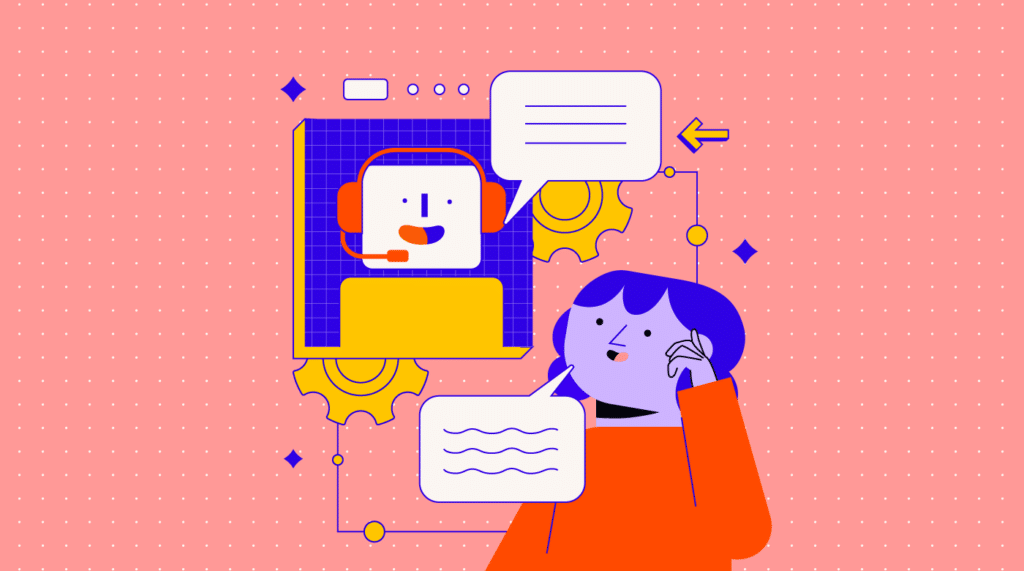Joseph Weizenbaum invented the first chatbot in 1966, but it took over twenty years before chatbots started to become popular with the invention of web-based chat programs like AOL Instant Messenger.
The early 2000s saw an increase in popularity due to the rise of social media platforms like Facebook, which made chatbots easier to implement on websites.
Today, businesses of all sizes benefit from customer service chatbots. In this blog post, we will explore the benefits of chatbots to your business, why they’re so popular right now, and how you can find the best chatbot for your needs.
What is a chatbot?
A chatbot is a computer program that conducts chat conversations with human users for either customer service or general information queries. They are designed to emulate human chat, making the customer experience more natural and personal.
Many companies find their chatbot software useful because they provide around-the-clock support, whereas traditional customer service chat can be limited. This makes it easier to respond to customer support requests at scale. Companies also use chatbots on their websites to answer customer questions and help with traditional customer service chat functions like sales, support, and billing inquiries.
How does a customer service chatbot work?
There are two types of chatbots: those based on scripts and those based on artificial intelligence (AI) systems. A script-based or rule-based chatbot responds to established questions with prewritten answers. Meanwhile, an AI chatbot uses machine learning to build a database of potential answers over time. This allows for extended conversations and more complex conversations with users.
A chatbot will typically ask customers introductory questions like what their name is and where they’re from before it begins to ask chat-based questions.
Creating chatbots for your website is simple. It doesn’t require any special coding or programming experience, just basic knowledge of how the chatbot works. Once you have installed the chatbot on your site, all you need to do is add a chatbot badge or link to your website so people know that they can chat with you.
From there, the chatbot builder integrates with your website in a way that doesn’t block information on your page. Your chatbot application shouldn’t be overly intrusive, so it’s essential to make sure it’s sized appropriately for your web page.
Essentially, you want to encourage customer queries, but you don’t want the virtual agent platform to distract from the rest of your company website.
What types of customer support are best provided by chatbots?
Chatbots are great for chat-based customer service questions like billing inquiries, sales, information requests, and technical support. Chatbots are also a good way to offer around-the-clock chat coverage on your website without needing live chat agents to be available (which can often be expensive).
If your company has a social media account, you can have a conversational chatbot on your messaging apps as well. This allows you to chat with your customers via social media, which is quickly becoming the first place customers go when they have a question or concern about a product or service.
Your messenger chatbot uses conversational AI to ask customers a list of questions to narrow down the conversation’s focus. That way, everyone’s on the same page (pun intended!).
Not all social media platforms have a business-to-business (B2B) or business-to-consumer (B2C) chat feature, but the ones that do are Facebook and Twitter.
How can customer service chatbots be used to collect customer data?
Some chatbots can be configured to collect customer feedback and data through chat conversations. This means that chatbots can be a great way for you to gather customer satisfaction metrics such as inquiries, concerns, wants or needs without needing human chat representatives available at all times. You’ll then have more time to do the important things, such as assessing your customer journey and customer satisfaction score and then taking action to improve or maintain your customer relationships.
How chatbots can improve the customer experience?
Chatbots empower human customer service representatives and provide a personalized experience to customers at a larger scale. Chatbots are not customer service representatives, but they understand basic customer chat requests. Because of this, they can direct customers through a solution-based customer experience or accomplish simple tasks, like receiving chat requests.
This leaves human chat representatives available to tackle other tasks. Plus, when customers need more in-depth assistance, chatbots can connect the customer with a human customer service representative.
By supporting human agents and quickly assisting customers with lower-level tasks, chatbots help improve customers’ user experience. A well-supported customer service department, managed by humans and chatbots alike, shows customers that the business is approachable and easier to contact.
Forbes reports that 62 percent of Americans and 65 percent of Europeans show interest in using a chatbot to communicate with businesses. Chatbots simplify tasks, save time and resources, and are a convenient, accessible way for customers to interact with a business.
In addition, chatbots are great at collecting customer data and feedback through chat conversations. This means chatbots can spread awareness about your brand and the work you do! Moreover, the data they collect provides leads, allowing you to gain a more complete understanding of who your customers are and how they prioritize their needs.
How do chatbots provide instant resolutions?
Chatbots can provide chat-based customer support that’s instant and automated. There are chatbots available for visitors to use twenty-four hours a day, which means the chat feature can always help to support your customers (even in the middle of the night).
Normally, these customers would be sitting in a phone queue, but with chatbot technology, they’re quickly handled, and then they can move on with the rest of their day.
Having chatbots that can chat around the clock with some level of personalized assistance is a great way to provide better customer support for common chat inquiries.
Take Domino’s AnyWare campaign, for example. Domino’s integrates chatbots with social media, messaging services, and AI devices, like Twitter, Slack, and Amazon Alexa. Through AnyWare, customers can order pizza almost instantly, even just by texting an emoji. With such widespread availability, Domino’s allows customers to order pizza faster and more directly.
By the way: since introducing AnyWare, Domino’s has seen its stock go up 217 percent.
How do chatbots help customers resolve their own issues?
Chatbots can help visitors resolve their chat-based customer service requests on their own. For example, chatbots can provide chat-based customer service to visitors by asking questions and following a decision tree that you can customize for your business. A flexible decision tree can, for instance, help a company avoid a headache that costs online businesses trillions a year: cart abandonment (standing at 81 percent for all sectors as of 2021). A chatbot that uses decision trees can alleviate this by engaging in a conversation that helps get customers to exactly what they want. Customers are thus less frustrated and are more likely to convert.
Here are examples of the types of questions that a chatbot should be able to answer instantly:
- When are you open?
- Are you running any sales right now?
- What are your most popular products?
- What’s your refund policy?
- Where’s my order?
- Where are you located?
If chat visitors aren’t satisfied with their customer experience, chatbots can also ask if they’d like an agent to help them and seamlessly connect customers to live support.
Best chatbots for your customer service
There are many functions and abilities that chatbots can perform, but you might not need all of them. Before choosing a chatbot for customer service, take a good look at what your goals are. What do you need the chatbot to cover? What do you not want it to cover?
Consider what type of chatbot will most benefit your business. Will you need a simple, script-based chatbot, or are you looking for advanced support through AI?
When you’ve got that nailed down, it’s time to go online and research your options. Compare factors such as user interface, usability, financial value, and integrations. Do you need a chatbot that integrates with a messaging system, like Facebook Messenger? Do you need to prioritize user engagement with live chat software for websites? How much money are you willing to spend on a chatbot service? How easy to use is each chatbot service?
And if you’re worried that your business isn’t big enough for a chatbot, think again. Some of the newest offerings are available for as little as forty dollars a month and require zero training.
What types of customer service chatbots can you choose from?
There are many different chatbots you can use for your business. Here is a list of some chatbot services you may want to consider:
- Facebook chatbots (Facebook Messenger)
- Skype chatbots (Skype)
- Kik chatbots (Kik Messenger)
- Chatbots for businesses on SMS
- Chatbots that chat with customers via email
What should you look for in a customer service chatbot?
The bot you choose should be able to provide chat-based customer service that’s instant, automated, and personalized.
You should also program your chatbot for customer journey optimization. The customer journey is the chatbot’s programmed path, which includes the questions the chatbot will ask and your customized decision tree.
To help, check out our pick of the best chatbots available on the market today
Need expert help selecting the right Support & Helpdesk Software?
If you’re struggling to choose the right software, let us help you. Just share your needs in the form below and you’ll get free access to our dedicated software advisors who match and connect you with the best vendors for your needs.
How do customer service chatbots use AI and machine learning?
Chatbots emulate human conversation, which means they need to understand what you’re saying and respond accordingly.
This is where AI comes in. AI chatbots seem like real people because they help customers understand what they are asking and direct the conversation appropriately. Some of the most common forms of AI-powered chatbots use natural language processing, chatbot-specific chat protocols like Facebook chatbots or Skype chatbots, and machine learning.
These forms of AI enable the bot to understand exactly what you’re saying and respond in a way that’s more humanlike than just using preprogrammed scripts. This makes chatting with your company chatbot seem more natural, which is one reason why chatbots are becoming popular right now. People want to feel like they’re having a conversation with another human instead of just talking at their computer screens.
Believe it or not, chatbots are also able to help market your company. Chatbot marketing is where your AI bot asks a series of questions to specific customers and offers personalized promotions based on their needs. This does two things:
- It helps a potentially frustrated customer out, improving customer loyalty and retention rates.
- It markets more of your products and services at the same time, improving your odds of repeat customers.



